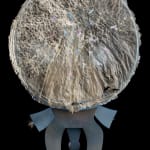-
Artworks
ROBERT JAMES (JIM) SCHOPPERT (1947-1992) TLINGIT
Seal Dancer Spirit Drum, 1983wood, acrylic paint, gut, feathers, and embroidery floss 36 x 24 x 8 in (91.4 x 61 x 20.3 cm), measurements reflect dimensions without custom pedestal, with: 68 x 24 x 12 in (172.7 x 61 x 30.5 cm)
signed and dated, "Schoppert 1983".LOT 75
ESTIMATE: $25,000 — $35,000
PRICE REALIZED: $21,960.00Further images
Jim Schoppert was among the most innovative Alaska Native artists of the 20th century. Born in 1947 in Juneau, he worked at the intersection of Alaskan Native and Euro-American art...Jim Schoppert was among the most innovative Alaska Native artists of the 20th century. Born in 1947 in Juneau, he worked at the intersection of Alaskan Native and Euro-American art and life. He received a BFA from the University of Alaska and an MFA from the University of Washington and was adept in a range of media, including ivory engraving, carving, sculpture, printmaking, and painting, all of which he frequently combined in complex multimedia sculptures such as Seal Dancer Spirit Drum. While he is best known for the large scale carved and painted abstract wooden panels in which he fragmented and rearranged elements of Northwest Coast formline design, he adapted diverse cultural forms and styles in pursuit of new possibilities for what he called an “uninterrupted” future of Tlingit art.
His drum-dancer masks, for example, are free-standing sculptures begun in 1980 that are based on Yup’ik kegginaqut dance masks, shamans’ drums, and yua (spirit) figures. These works creatively explore and make variations on the conventions of Arctic mask making, combining recurrent motifs found in Yup’ik masks such as large grinning mouths filled with wooden peg teeth, outstretched flippers and paddle-like hands, and feathers or hoops. Seal Dancer brings this impulse fully into the round in a dynamic and humorous fashion with a figure whose face emerges from the body of a seal, bent legs and gently swaying feathers evoking the movement of dance. The patterning and bright acrylic palette take on a jubilant nature, combining to transform the historically inspired forms into a contemporary mode.
The stretched gut-skin drum of Seal Dancer has been decorated with small painted seals, frolicking across the surface like expressionistic brush strokes which Schoppert considered “abstract movement from a different language base.” Inspired by the complexity of Yup’ik masks and dancing, Schoppert combines the guiding source of a dancer’s rhythm – the drum – with the language and repetitive beats and strokes of modernist painting, having been equally inspired by and interested in the primitivist pursuits of the Surrealists and Abstract Expressionists. He thus finds new possibilities for Indigenous art in the meeting of the quintessential forms and materials of Alaskan Native art and the visual language of the Euro-American avant-garde, drawing forth the relationship between Alaskan Native artistic heritage and the broader history of Western modernism.
Christopher T. Green, PhD
References: Some years after Schoppert’s death, the Anchorage Museum of History and Art organized a traveling exhibition and catalogue, Instrument of Change: Jim Schoppert, 1947-1992, Retrospective Exhibition, (Anchorage: Anchorage Museum of History and Art, 1997).
Provenance
Stonington Gallery, Seattle, WA, 2015;
Acquired from the above by John and Joyce Price, Seattle, WA.Exhibitions
Seattle, WA, Stonington Gallery, Masters of Disguise I - Group Mask Exhibition, 4 - 28 June 2015, cat. no. unknown.
Join our mailing list
* denotes required fields
We will process the personal data you have supplied in accordance with our privacy policy (available on request). You can unsubscribe or change your preferences at any time by clicking the link in our emails.








